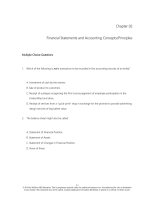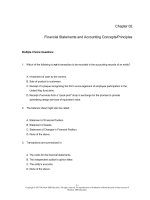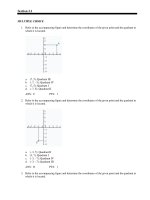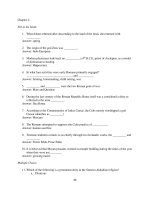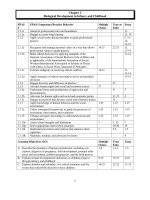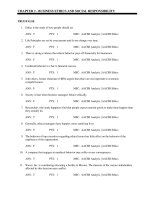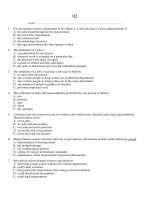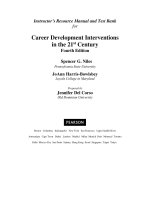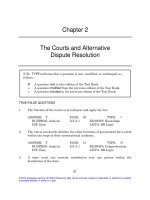Theories of human learning what the professor said 6th edition lefrancois test bank
Bạn đang xem bản rút gọn của tài liệu. Xem và tải ngay bản đầy đủ của tài liệu tại đây (247.55 KB, 12 trang )
Chapter 2
Early Behaviorism: Pavlov, Watson, and Guthrie
Chapter Outline
I.
This Chapter
II. The Beginnings of Scientific Psychology
III. Ivan P. Pavlov (1849-1936)
A. Classical Conditioning
B. Contiguity and Reinforcement
C. Variations in Contiguity
D. Backward Conditioning and Biological Predispositions
E. Findings in Classical Conditioning
F. Educational Implications of Pavlov’s Classical Conditioning
G. Pavlov’s Classical Conditioning: An Appraisal
IV. John B. Watson (1878-1958)
A. Behaviorism
B. Watson’s Learning: A Classical Conditioning Explanation
C. Conditioned Emotional Learning
D. Transfer
1.
Positive Emotions
2.
The Controversy
E. Watson’s Environmentalism
F. Higher Learning
G. Practical Applications of Watson’s Psychology
H. An Appraisal of Watson’s Behaviorism
V. Edwin Guthrie (1886-1959)
A. Guthrie’s Law of One-Shot Learning
B. The Role of Practice and Repetition
C. Movement Produced Stimuli (MPS)
D. Habits
E. Forgetting
F. Reward and Punishment
G. Practical Applications of Guthrie’s Theory: Forming and Breaking Habits
H. An Appraisal of Guthrie’s One-Shot Learning
VI. Evaluation of Early Behavioristic Theories
VII. Summary
15
Chapter 2
Early Behaviorism
Discussion Questions
1.
Reflecting on your role as a student, what are some unpleasant unconditioned
stimuli that you recall being paired with your learning or teaching. What are some
pleasant unconditioned stimuli?
2.
Based on Pavlov’s classical conditioning, what impact does classroom climate or a
teacher’s caring attitude potentially have on student learning? Provide some
examples with your responses.
3.
Based on what was learned in Chapter 1, what would be said today about Watson’s
research with Little Albert?
4.
In an aside by the Professor (footnote 8), the author refers to the omitted references
to Watson’s sex research. Based on what has been discussed thus far about
behaviorism, why is it that we have tendencies to remember this track of his
research?
5.
What are the ethical implications concerning Watson’s statement about the claim
that he could make anything he wished out of healthy infants providing he had
control of their environment?
Group Exercises
1.
Have class participants role-play scenarios depicting unpleasant and/or pleasant
unconditioned stimuli being paired with learning events. Class participants should
also depict how the inverse reaction could be achieved within the same setting.
2.
This activity highlights the potential effectiveness of contiguity and repetition in the
presentation of stimuli inducing learners towards making connections to new
stimuli.
a.
b.
c.
d.
e.
Prepare three decks of flashcards. The first deck contains Spanish words on
one side and its English counterpart on the reverse side.
A second deck contains the same Spanish* words as the first deck; however,
this deck also has illustrations with its respective Spanish words. Also include
the corresponding English word on the back.
The third deck should include the Spanish word, an illustration, and the
English counterpart on the same side of the card.
Divide the class into three groups. Each group receives one of the flashcard
decks.
Allow the three teams to review their respective flashcards for between five to
ten minutes.
16
Chapter 2
f.
g.
h.
*
3.
Early Behaviorism
At the end of the time limit, assess how many of the new Spanish words the
class participants remember. Use the first flashcard deck for this evaluation
revealing the Spanish words to the class.
Class participants will write down the English word equivalent when they see
the Spanish word on the flashcards.
Chart the results of the three groups. Discuss what the results depict.
NOTE: Spanish is used here for demonstration purposes only. The instructor
may want to consider using another foreign language, especially if class
participants have previous experiences with Spanish.
Discuss the differences in the benefits of kinesthetic repetition versus mental
repetition. Kinesthetic repetition is represented by someone learning to throw a ball
with your father. Mental repetition is represented by rote memory exercises such as
drilling on the multiplication tables. Have class participants prepare a chart of
positive and negative attributes for each approach.
Web Links
All-About-Psychology.com
A website serving as a gateway to information and resources pertaining to psychology,
definitions, theory, practical applications, careers, and debates.
Classics in the History of Psychology
/>This is a website dedicated to providing researchers, teachers, and students the history of
psychology with access to historical scholarly literature pertaining to psychology and
allied disciplines.
The AmeobaWeb Psychology Resources
/>A website devoted to various branches of psychology. For pertinence to this chapter,
click on the link, History of Psychology.
PsychLab On-Line
/>This site allows students to conduct simulated online classical conditioning experiments.
Encyclopedia of Psychology
/>This website maintains links to many topics and people related to psychology and its
history.
17
Chapter 2
Early Behaviorism
Multiple Choice Test
WWW
1. In Pavlov’s conditioning experiment, the salivation which followed the buzzer was
the
a.
conditioned stimulus.
b.
unconditioned response.
c.
conditioned response.
d.
reinforced response.
REF: Classical Conditioning
ANS: C
2.
With regard to Pavlov’s experiment with conditioning, which of the following is
false?
a.
Classical conditioning may also be used with humans.
b.
Deaf animals may also be classically conditioned.
c.
The unconditioned response is a muscular-glandular response to the
environment.
d.
Unconditioned responses are unpredictable.
REF: Classical Conditioning
ANS: D
3.
Reflexes are defined as
a.
non-intentional unlearned behaviors.
b.
voluntary and controlled behaviors.
c.
complex unlearned behaviors.
d.
responses that cannot be conditioned.
REF: Classical Conditioning
ANS: A
4.
In classical conditioning which of the following is true of an unconditioned
stimulus?
a.
The nature of the response to the unconditioned stimulus will vary with the
presentation.
b
The conditioned stimulus will eventually substitute for the unconditioned
stimulus.
c.
The unconditioned stimulus is a new behavior.
d.
The unconditioned stimulus is an internal state of the subject.
REF: Classical Conditioning
ANS: B
18
Chapter 2
Early Behaviorism
5.
With regard to delayed pairing and contiguity, which of the following is true?
a.
Contiguity applies to delayed pairing.
b.
Contiguity does not apply to delayed pairing.
c.
Contiguity applies to simultaneous pairing only.
d.
Contiguity applies to backward pairing only.
REF: Variations in Contiguity
ANS: A
6.
Trace conditioning involves
a.
CS beginning and ending before US.
b.
US beginning and ending before CS.
c.
US and CS overlap.
d.
CS and US are presented at the same time.
REF: Variations in Contiguity
ANS: A
7.
Variations in contiguity and presentation include
a.
backtracking conditioning.
b.
forward conditioning.
c.
delayed conditioning.
d.
operant conditioning.
REF: Variations in Contiguity
ANS: C
8.
The conditioning of actions involving glands or involuntary muscles is called
a.
interoceptive conditioning.
b.
elimination of bed-wetting.
c.
habit formation.
d.
stimulative conditioning.
REF: Classical Conditioning
ANS: A
9.
According to Pavlov, repeated pairing of CS and US
a.
is necessary only with animals.
b.
is a normal part of acquisition.
c.
indicates mental impairment.
d.
is necessary due to forgetting.
REF: Findings in Classical Conditioning
ANS: B
19
Chapter 2
Early Behaviorism
10. Presenting the CS repeatedly without the US will result in
a.
a stronger association between the two stimuli.
b.
no effect on acquisition
c.
an unknown effect.
d.
the elimination of the conditioned response.
REF: Findings in Classical Conditioning
ANS: D
11. The following characterizes spontaneous recovery:
a.
The CR returns at the former intensity.
b.
The CR returns at a lesser intensity.
c.
The CR returns at a higher intensity.
d.
The subject behaves as before the conditioning occurred.
REF: Findings in Classical Conditioning
ANS: B
12. Contiguity may be described as
a.
that which is ongoing, a process.
b.
the effect of a stimulus.
c.
that which occurs after a response.
d.
simultaneous, or near occurrence of an event.
REF: Contiguity and Reinforcement
ANS: D
13. Watson described consciousness as
a.
the effect of a stimulus.
b.
important and relevant to learning.
c.
neither definite nor useable.
d.
the source of responses.
REF: Behaviorism
ANS: C
14. Which of the following is a learned response?
a.
blinking in response to a burst of air
b.
raising one’s hand in response to a question
c.
salivating in response to the sight of food
d.
fear in response to a loud noise
REF: Behaviorism
ANS: B
20
Chapter 2
Early Behaviorism
15. The Little Albert demonstration illustrated
a.
the effects of emotional conditioning.
b.
children are poor research subjects.
c.
reinforcement delays learning.
d.
children have a natural fear of rodents.
REF: Conditioned Emotional Learning
ANS: A
16. Which of the following describes John Watson?
a.
He was concerned with the relationship of behavior to mental concepts.
b.
He used the concept of introspection to explain behavior.
c.
He was concerned with observable behavior as it relates to observable events
in the environment.
d.
He believed that a wide range of genetically transmitted emotions accounted
for behavior.
REF: Behaviorism
ANS: C
WWW
17. Ninety percent of students fail a math test for three days in a row. The teacher
introduces another math test on a fourth day and the students moan in dismay. This
occurs because of
a.
stimulus generalization.
b.
stimulus discrimination.
c.
a conditioned response.
d.
a conditioned stimulus.
REF: Transfer
ANS: A
18. According to behaviorists, discrimination involves
a.
responding to those of a different gender differently.
b.
responding to each stimulus separately, depending on the stimulus
characteristics.
c.
responding to each person differently despite obvious differences.
d.
responding positively only to those similar to oneself.
REF: Findings in Classical Conditioning
ANS: B
19. Watson might give advice to first-time parents in which of the following ways?
a.
Get to know your child’s inherent personality.
b.
Both genetics and environment affect personality. Change what you can and
accept the rest.
c.
Your child’s personality will depend upon your influence.
d.
Your child can become whatever he/she chooses to be.
REF: Watson’s Environmentalism
ANS: C
21
Chapter 2
Early Behaviorism
20. Watson’s hospital experiment with Little Albert resulted in a conditioned fear
response to the presence of a rat. The unconditioned fear response, according to
Watson, was
a.
a result of the child’s temperament.
b.
emotional dysfunction of the child.
c.
a random emotional response that continued due to reinforcement.
d.
an emotional reflex.
REF: Conditioned Emotional Learning
ANS: D
21. Backward pairing
a.
though generally ineffective, has been shown to occur in instances involving
preparedness to learn by the organism.
b.
according to research, is only theoretically possible since learning has yet
been empirically proven to occur by this method.
c.
is an approach to the building of relationships among those who possess the
character trait of shyness.
d.
despite claims to the contrary, has proven to be the most effective method of
pairing in terms of longevity of learning.
REF: Backward Conditioning and Biological Predispositions
ANS: A
22. In response to a craving for chocolate, a young student purchased a large number of
candy bars, and throughout a single evening ate all of them. The evening resulted in
nausea to the point that he stayed in bed the entire next day. He has not liked
chocolate since. Guthrie’s technique that would explain the response is called
a.
the Threshold Method.
b.
the Fatigue Method.
c.
the Extinction Method.
d.
the Method of Incompatible Stimuli.
REF: Practical Applications of Guthrie’s Theory: Forming and Breaking Habits
ANS: B
23. With regard to learning theory, behaviorism should be viewed as
a.
a comprehensive, objective view of human learning.
b.
an oversimplified explanation failing to address symbolic functioning.
c.
contradictory to the claims of cognitivism.
d.
foundational in its assertions, a necessary step in moving from the simple to
the complex.
REF: Evaluation of Early Behavioristic Theories
ANS: D
22
Chapter 2
Early Behaviorism
24. A mathematics teacher comes to school in a bad mood and introduces fractions that
day. Students seem unmotivated to learn. This can be attributed to
a.
the pairing of the teacher’s attitude with the content.
b.
the negative environment in the room.
c.
most students dislike fractions.
d.
the teacher utilizing ineffective teaching strategies.
REF: Educational Implications of Pavlov’s Classical Conditioning
ANS: A
25. Given a tabula rasa assumption, the following is true.
a.
Each individual chooses who he may become.
b.
Little can be known about learning.
c.
Animals and humans may be made into anything a controller so chooses.
d.
Animals may be shaped by a controller, but humans resist control and must
cooperate.
REF: Watson’s Environmentalism
ANS: C
26. According to Guthrie, when an S-R connection is made, learning has taken place.
Which of the following is true of this connection?
a.
Repeating the pairing will strengthen the connection.
b.
The connection is as strong as it will ever be.
c.
The connection between S and R is an illusion.
d.
Reinforcement of the R will strengthen the connection.
REF: Guthrie’s Law of One-Shot Learning
ANS: B
27. William James’ approach to understanding human behavior involved
a.
controlled experiments, contiguity, and reinforcement.
b.
objectivity, control, and measurement.
c.
stream of consciousness, wholeness, and introspection.
d.
stimuli, responses, and observation.
REF: The Beginnings of Scientific Psychology
ANS: C
WWW
28. An absolute threshold involves
a.
the most stimulation before an organism shuts down.
b.
the point beyond which response may not be objectively measured.
c.
the least amount of stimulation required for sensation.
d.
the least amount of response which may be observed.
REF: The Beginnings of Scientific Psychology
ANS: C
23
Chapter 2
Early Behaviorism
29. Selective breeding of racehorses may be described as
a.
capitalism.
b.
eugenics.
c.
stimulus discrimination.
d.
transfer.
REF: Watson’s Environmentalism
ANS: B
30. Nature is to nurture as
a.
stimulus is to response.
b.
contiguity is to reinforcement.
c.
stimulus generalization is to stimulus discrimination.
d.
biology is to the environment.
REF: Watson’s Environmentalism
ANS: D
31. According to Guthrie, One-Shot Learning applies to
a.
the intellectually gifted.
b.
all learners.
c.
laboratory animals.
d.
those who receive a particular type of instruction.
REF: Guthrie’s Law of One-Shot Learning
ANS: B
WWW
32. Guthrie attributes forgetting to
a.
the aging process.
b.
a failure to reinforce.
c.
an inadequate pairing process.
d.
new learning replacing old.
REF: Habits
ANS: D
33. Making a smoker chain smoke multiple packs of cigarettes may break the habit
according to Guthrie because
a.
nicotine is stored for an indefinite period.
b.
the requirement acts as a punishment.
c.
the smoker recognizes this as an excess.
d.
fatigue interrupts the response.
REF: Practical Applications of Guthrie’s Theory: Forming and Breaking Habits
ANS: D
24
Chapter 2
Early Behaviorism
34. The Threshold Method of breaking a habit involves
a.
superstition.
b.
resolutions made prior to marriage.
c.
faint stimuli which fail to elicit a response.
d.
lack of opportunity to engage in the habit.
REF: Practical Applications of Guthrie’s Theory: Forming and Breaking Habits
ANS: C
35. Contiguity is
a.
when the occurrence of one event depends on the occurrence of another.
b.
simultaneous pairing of stimulus and response.
c.
selling the soap to win the car.
d.
trace conditioning.
REF: Contiguity and Reinforcement
ANS: B
36. Systematic Desensitization is most similar to
a.
the Fatigue Method.
b.
Movement Produced Stimuli.
c.
the Incompatible Stimuli Method.
d.
the Threshold Method.
REF: Practical Applications of Guthrie’s Theory: Forming and Breaking Habits
ANS: D
37. The best explanation for Movement Produced Stimuli is
a.
habitual response.
b.
reinforcement.
c.
contiguity.
d.
One Shot Learning.
REF: Movement Produced Stimuli (MPS)
ANS: C
38. Guthrie believed that punishment changes habits due to
a.
interruption of the habit.
b.
behavior modification.
c.
contiguity.
d.
Movement Produced Stimuli.
REF: Reward and Punishment
ANS: A
25
Chapter 2
Early Behaviorism
WWW
39. Conditioned responses
a.
can never be eliminated.
b.
only persist with repeated pairing.
c.
must be periodically counterconditioned.
d.
are remarkably durable.
REF: Findings in Classical Conditioning
ANS: D
26
